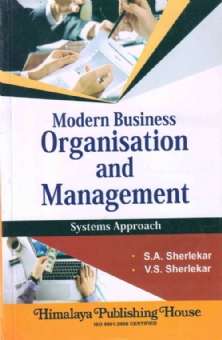Modern Business Organisation and Management
no information available
This book is designed to provide a broad and integrated introductory analysis to the study of organizations and their management-applicable to both the private sector organizations. The work of managers may be divided into subject fields. e.g., production, finance, marketing and personnel. It may also be divided into management processes, e.g., planning, organizing, directing and controlling. These are simply two different approaches to the same body of activities, viz. Business management / Administration. The marketing manager must plan, organize, assemble resources, supervise and control, just as any other executive. Management is a necessary part of the work n any all of the functional areas of business. This book concentrates on both sides of the business, viz., subject fields such as production, marketing, finance and personnel, as well as processes such as planning, organizing, directing, coordinating and controlling the activities and the personnel of the enterprise. The theme of human relations is pervading throughout in the book. Plans are made to guide human activity and secure best and deal with jobs for the people and the relationships between these people. Direction cum motivation assures maximum productivity and satisfaction. Control is effective only if human behaviour conforms to plans. People are our greatest assets with unlimited potential for growth and development. In other words, human relations is not a separate issue, but an ever-present one. Under the system approach, we have the best coordination and integration of all resources and functions in order to attain the stated objectives of productivity and satisfaction. Contents : PART I : THE BUSINESS SYSTEM 1. Nature and Scope of Business 2. Business System and Its Environment 3. Economic and Social Objectives PART II : THE BUSINESS STRUCTURE 4. Forms of Business Organizations 5. Proprietory Organizations 6. Company Organization 7. Co-Operative Organization 8. Public Enterprises 9. Business Combinations 10. Company Formation 11. Company Management and Control 12. Office Organization and Management PART III : PRE-PROMOTION PROBLEMS 13. Setting-Up a New Enterprise 14. Location and Layout 15. Optimum Firm PART IV : GENERAL MANAGEMENT 16. Management 17. Evolution of Management Thought 18. Planning 19. The Organization 20. Organising Process 21. Delegation and Decentralization 22. Forms of Internal Organization 23. Management-In-Action 24. Controlling 25. Small Business 26. Rationalization and Industrial Productivity 27. Scientific Management PART V : PRODUCTION MANAGEMENT SYSTEM 28. Management of Work 29. Production Management 30. Production Planning and Control 31. Materials Management (PART-I) 32. Materials Management (PART-II) PART VI : MARKETING MANAGEMENT SYSTEM 33. Marketing Functions 34. Marketing Mix (Part-I) : Product 35. Marketing Mix (Part-II) : Price 36. Marketing Mix (Part-III) : Promotion 37. Marketing Mix (Part-IV) : Distribution 38. Marketing Research 39. Organized Commodity Markets 40. Speculation on Organized Markets 41. Hedging on Forward Markets 42. Forward Markets 43. Transport System 44. Insurance System 45. International (Global) Marketing PART VII : FINANCIAL MANAGEMENT SYSTEM 46. Sources of Finance (Corporate Securities) 47. Business Finance (Part-I) 48. Business Finance (Part-II) 49. Financial Institutions 50. The Securities Market 51. Financial Controls PART VIII : HUMAN RESOURCES MANAGEMENT SYSTEM 52. Personnel Function 53. Human Factor in Industry 54. Personnel Planning / Selection 55. Employee Training / Development 56. Compensation To Employees (Part-I) 57. Compensation To Employees (Part-II) 58. Personnel Problems 59. Worker`s Participation in Management 60. Trade Unions PART IX : Business and Government 61. Management In A Mixed Economy (Part-I) 62. Management In A Mixed Economy (Part-II) 63. Regulation of Restrictive Trade Practices 64. Legislation for Consumer Protection Bibliography ... Read more Read less











